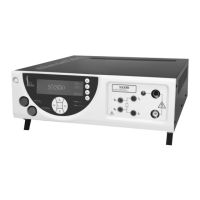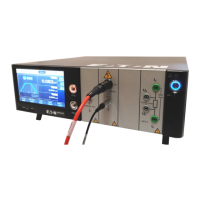XS series operating manual
XS user manual v0.55 - 138 -
Ground continuity measurement
On a unit or an electrical device using or generating hazardous voltages, ground continuity
measurements insure that all the accessible protective parts are correctly connected to the protective
earth connection wire.
This measurement is almost a low resistance measurement except that it has to be performed with a
high current, mostly in AC .
The principle is to flow a current between each metallic accessible parts and the protective earth
connection, to measure the voltage drop between the 2 parts and to check with the Ohm’s law that the
equivalent resistance is lower than the standard required value.
Current selection
The measurement current is defined by the safety standards which have to be used for each product.
According to the main standards, this high current is comprised between 10 and 25 A AC or equal to 2
times the nominal operating current of the device.
The choice is justified by the fact that the protective earth connections have to be able to flow the fault
current for the maximum value of the unit operating current and this during the reaction time of the other
protective devices (fuses, breakers, etc...)
Voltage selection
This is the open voltage of the current generator used for the measurement. This voltage, mostly given
by each safety standards is mandatory a low value (lower than the threshold defining a hazardous
voltage) but it must allow the measurement current flowing, taking care of the voltage drops between the
generator and the measurement points.
The open voltages are comprised between 6 and 12 AC volts.
Test time
Unlike a simple resistance measurement, the time that the current is being flowing for the ground
continuity measurement is important because of the ‘Safety’ function of the tested connection.
Beyond the ohm value evaluation, it is mandatory to test the quality of the connection to the earth
potential (diameter of the wire, solders quality, screwing quality, ...). A manufacturing fault of one of
these connections may in certain circumstances give an immediate correct ohm value, but increasing
quickly by heating causes by the high current value used for the test : this high current can produce a
break of the wire (wounded wire, which diameter becomes too small).
This is why some standards are requiring a minimum test time from 1 to 5 minutes for this measurement.
Other standards don’t give any time indication, but it is advised to apply for type test a minimum time of 1
minute and for series tests at least 10 seconds.

